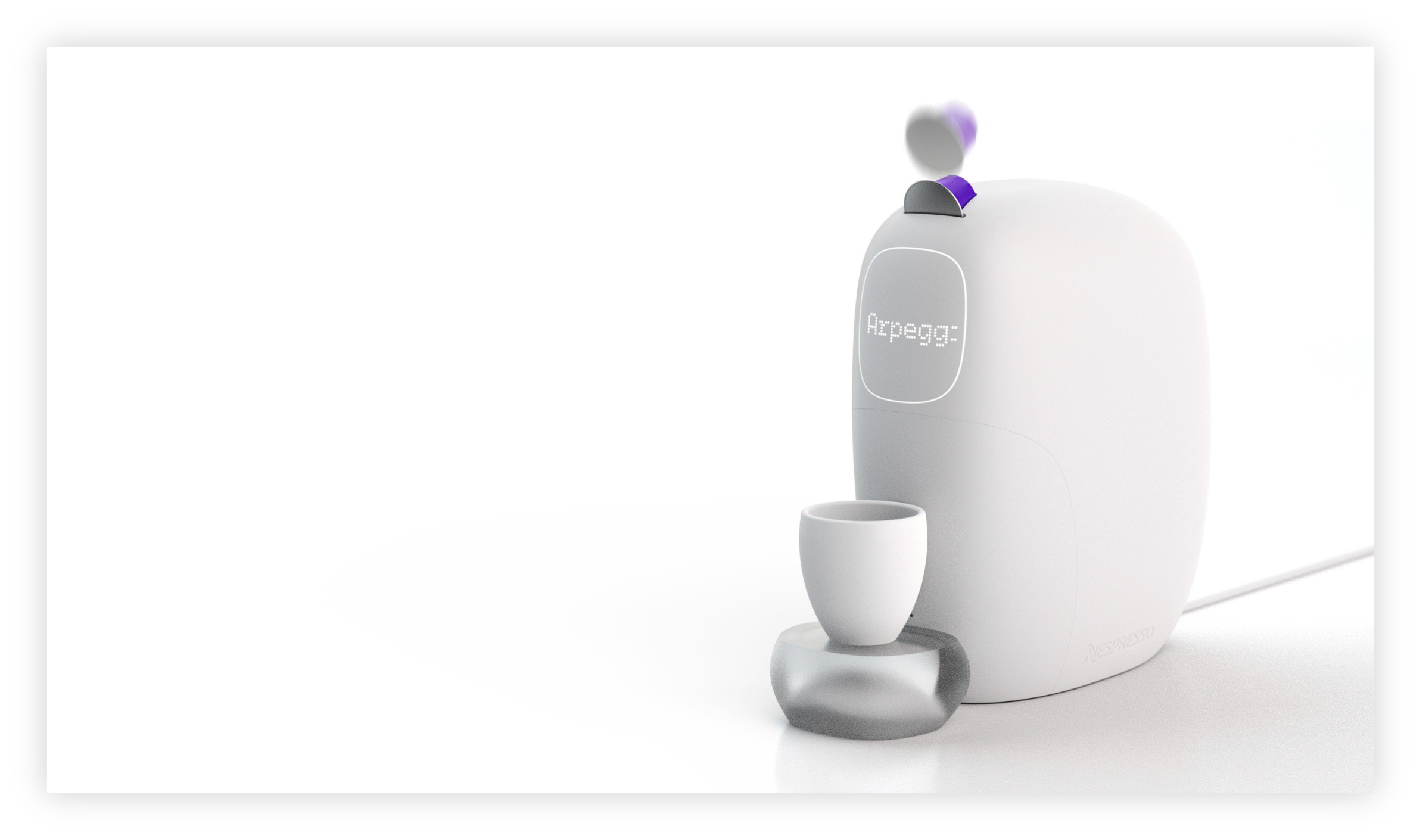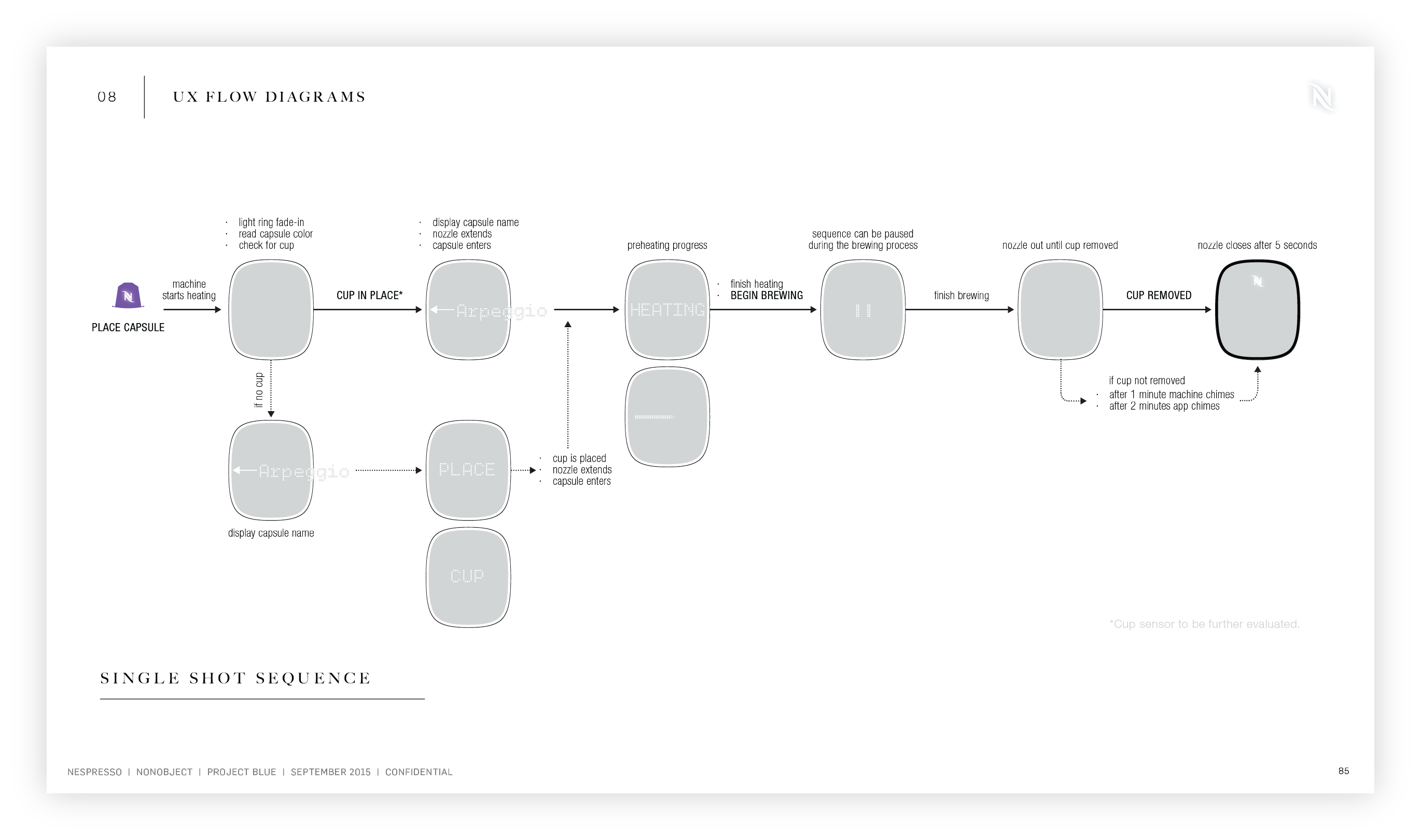Nespresso Wi-Fi Espresso Machine UX
Role: UX Lead
Contribution: Hardware UX, iOS app
Team: 4 designers across entire project
Process
Unifying Hardware and Software
The team worked closely together from the beginning until we developed a unified product strategy.
Thereafter, I unblocked the hardware team by fleshing out the hardware UX and MMI with them before breaking off to focus on the companion iOS app.
Thereafter, I unblocked the hardware team by fleshing out the hardware UX and MMI with them before breaking off to focus on the companion iOS app.

Background
Replacing the Bluetooth-enabled Prodigio
The Prodigio line-up was Nespresso’s first attempt at an IoT coffee machine.
Leveraging Bluetooth, it could
Leveraging Bluetooth, it could
- give you details about your machine through the app on your phone.
- count the number of capsules that passed through the machine and deduct it from your inventory.
- schedule the brewing of a capsules at a specific time.






Understand
Insights from User Feedback
We studied user reviers and interviewed existing Prodigio owners to learn about the product’s shortcomings.
Users were upset that the Bluetooth connectivity and smart functionality did not enhance their experience in any way over a normal Nespresso machine.
Users were upset that the Bluetooth connectivity and smart functionality did not enhance their experience in any way over a normal Nespresso machine.

Align
Prioritising User Needs: Coffee without App
I proposed to the team that the product UX should not require the app to make a coffee; that would remain solely the domain of the machine.
Smart features and the app should strive to simply value-add to the users experience by
Smart features and the app should strive to simply value-add to the users experience by
-
automatically ordering capsules when they run low
- providing content relevant to your coffee habits such as recipes or articles
- enabling further fine tuning of the machine’s brew parameters

Develop
Hardware UX: Sensors, Specs, Mechanisms
I worked with the hardware team to design ensure that the machine’s MMI was intuitive, delightful, and brought added value compared to existing machines like the Prodigio.




We implemented:
- A colour sensor to accurately detect which capsule is being used for SKU-specific brew parameters.
- An automated loading tray to precisely track consumption with no error.

- A large, legible matrix display with capacitive touch controls integrated into the retracting nozzle. I provided the engineers with the display specs and timings for the animation and nozzle.

Here are some examples of the hardware UX diagrams I created for the product bible.



Develop
App UX: Flow, Wireframes, Prototypes
In designing the companion app, I first laid out the highest level components:
These were used to create IA for the app and initial wireframes.
- articles
-
inventory
-
boutique
-
recipes
-
settings
These were used to create IA for the app and initial wireframes.

To test the concept, I made some higher fidelity screens. Initial impressions internally were that the app felt oversimplified and arbitrary.

I quickly put together a clickable prototype from the wireframes and did some guerilla user testing. I received a lot of feedback regarding how many of the useful features were hidden behind too many steps, making the app feel dumb.
In response to the feedback, I switched to a card-based feed for the app home. The feed surfaces relevant sections of the app to the first screen intelligently, while the bottom bar convention lent familiarity to users.

Deliver
Final Designs: New Flow & Mockups
The goal of the app is to give the user what they need, when they want it. For example,
you can see from this UX flow diagram how users can access recipes as featured content, related recipes, or straight from the library, Each point of entry caters to a different context.
This time, guerilla user testing yielded positive results.
This time, guerilla user testing yielded positive results.

Onboarding:

Subscription / Webstore:


Recipes:

Settings:

Impact
Continuing a Partnership
Nespresso was impressed with our work and returned to work with us again for the milk portion of this coffee machine.
Given more time, we would have loved to sit with the SWEs to develop the app and do more user testing, but alas, the agency model proved brutal with its timeline.
Given more time, we would have loved to sit with the SWEs to develop the app and do more user testing, but alas, the agency model proved brutal with its timeline.